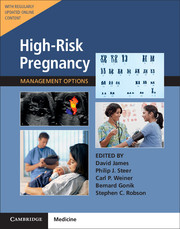Book contents
- Frontmatter
- Contents
- List of Contributors
- Preface
- Section 1 Prepregnancy Problems
- Section 2 Early Prenatal Problems
- Section 3 Late Prenatal – Fetal Problems
- Section 4 Problems Associated with Infection
- Section 5 Late Pregnancy – Maternal Problems
- 30 Substance Misuse in Pregnancy
- 31 Medication in Pregnancy
- 32 Hypertension in Pregnancy
- 33 Cardiac Disease in Pregnancy
- 34 Respiratory Disease in Pregnancy
- 35 Anemia and White Blood Cell Disorders in Pregnancy
- 36 Hematological Malignancies in Pregnancy
- 37 Thrombocytopenia and Bleeding Disorders in Pregnancy
- 38 Disorders of Coagulation in Pregnancy
- 39 Autoimmune Disease in Pregnancy
- 40 Diabetes in Pregnancy
- 41 Thyroid Disease in Pregnancy
- 42 Pituitary and Adrenal Disease in Pregnancy
- 43 Gastrointestinal and Liver Diseases in Pregnancy
- 44 Neurologic Complications in Pregnancy
- 45 Renal Disorders in Pregnancy
- 46 Spine and Joint Disorders in Pregnancy
- 47 Skin Disease in Pregnancy
- 48 Malignant Disease in Pregnancy
- 49 Pregnancy After Transplantation
- 50 Trauma in Pregnancy
- 51 Mental Health Disorders in Pregnancy
- Section 6 Late Prenatal – Obstetric Problems
- Section 7 Postnatal Problems
- Section 8 Normal Values
- Index
49 - Pregnancy After Transplantation
from Section 5 - Late Pregnancy – Maternal Problems
- Frontmatter
- Contents
- List of Contributors
- Preface
- Section 1 Prepregnancy Problems
- Section 2 Early Prenatal Problems
- Section 3 Late Prenatal – Fetal Problems
- Section 4 Problems Associated with Infection
- Section 5 Late Pregnancy – Maternal Problems
- 30 Substance Misuse in Pregnancy
- 31 Medication in Pregnancy
- 32 Hypertension in Pregnancy
- 33 Cardiac Disease in Pregnancy
- 34 Respiratory Disease in Pregnancy
- 35 Anemia and White Blood Cell Disorders in Pregnancy
- 36 Hematological Malignancies in Pregnancy
- 37 Thrombocytopenia and Bleeding Disorders in Pregnancy
- 38 Disorders of Coagulation in Pregnancy
- 39 Autoimmune Disease in Pregnancy
- 40 Diabetes in Pregnancy
- 41 Thyroid Disease in Pregnancy
- 42 Pituitary and Adrenal Disease in Pregnancy
- 43 Gastrointestinal and Liver Diseases in Pregnancy
- 44 Neurologic Complications in Pregnancy
- 45 Renal Disorders in Pregnancy
- 46 Spine and Joint Disorders in Pregnancy
- 47 Skin Disease in Pregnancy
- 48 Malignant Disease in Pregnancy
- 49 Pregnancy After Transplantation
- 50 Trauma in Pregnancy
- 51 Mental Health Disorders in Pregnancy
- Section 6 Late Prenatal – Obstetric Problems
- Section 7 Postnatal Problems
- Section 8 Normal Values
- Index
Summary
Introduction
Transplantation is an accepted therapeutic option for patients with end-stage organ failure. The first successful human kidney transplant took place in 1954. However, it was not until the 1960s that immunosuppression became available, and not until the 1980s, with the introduction of cyclosporine, that consistently acceptable graft and patient survival was achieved. With restoration of organ function, patients experience an overall improvement in their health, increased libido, and return of fertility.
The first post-transplant pregnancy occurred in March 1958 and was reported in 1963. It occurred in a patient who had received a kidney from her identical twin. This pregnancy resulted in cesarean delivery of a healthy boy. As transplantation has progressed, with improvements in surgical techniques and medical therapy and advances in immunosuppression, pregnancies have been reported in recipients of each organ type. Most outcomes reported have been in kidney transplant recipients. Issues that must be considered include maternal graft function and maternal health, the effect of pregnancy on graft function, and the effect of the medications and graft function on the developing fetus. There is also concern about the long-term effects of pregnancy on graft function. Finally, there is the question of whether more subtle and long-term effects, although not apparent at birth, may affect the growth and development of the offspring of these recipients or future generations. These issues are discussed in this chapter.
Organ Transplantation
Patients with end-stage renal disease who are receiving or will soon need dialysis are candidates for renal transplantation. Some common indications for renal transplantation are glomerulonephritis, diabetes, polycystic kidney disease, and hypertension. In 2015 in the United States, 18,597 kidney transplants were performed. The 1-year graft survival rate for patients transplanted in 2014 was 97.4% for living donors and 93.6% for deceased donor recipients.3 Technical advances that allow laparoscopic removal of living donor kidneys have helped make living donation more acceptable, removing disincentives related to pain and prolonged recovery.4 Standard requirements for donor–recipient pairs for kidney transplantation are ABO compatibility and a negative pretransplant cross-match (i.e., absence of preformed antidonor antibodies). Efforts to increase the number of kidney transplants include use of ABOincompatible organs, donor treatment protocols to remove antidonor antibodies, and exchange programs.
- Type
- Chapter
- Information
- High-Risk Pregnancy: Management OptionsFive-Year Institutional Subscription with Online Updates, pp. 1445 - 1469Publisher: Cambridge University PressFirst published in: 2017



